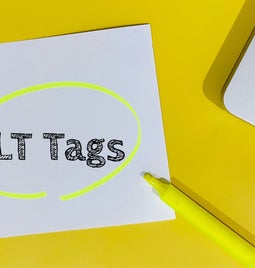Google Cracks Down on Fake E-E-A-T Content: What You Should Know
We may receive a commission from our partners if you click on a link and purchase a product or service on their website. Learn more

Google has updated its Search Quality Raters guidelines to include webpages containing fake E-E-A-T content. These are the rules third-party evaluators follow to assess the quality of search engine content. This change aims to help evaluators better identify different kinds of deceptive content, helping Google improve its search results in the process.
But what makes E-E-A-T content “fake”? And how can you avoid making this major SEO mistake on your own business website? Below, I’ll reveal the changes to Google’s Search Quality Raters guidelines and what they tell us about effective E-E-A-T content in 2025.
💡 Quick E-E-A-T Refresher
E-E-A-T isn’t a direct ranking factor – it’s an official framework used by Google to assess the value and quality of your website’s content. Each letter stands for:- Experience: Does your site content reflect your own firsthand experiences?
- Expertise: Is the information on your website accurate and fact-checked?
- Authority: Are you viewed as an authoritative name in your industry?
- Trustworthiness: Can users trust the content you’ve created?
How Has Google Changed Its Search Quality Raters Guidelines?
To see the changes to Google’s Search Quality Raters guidelines, you’ll need to open the PDF and scroll down to Section 4.5.3 on page 36. Google has rewritten this section in much more depth to highlight what exactly makes certain E-E-A-T content deceptive.
In the PDF, this is what Google defines as a webpage with a deceptive purpose:
“The page or the website superficially appear to have one purpose, but in fact exist for a different reason.”
After this definition, Google lists a couple of examples of webpages with a deceptive purpose:
- Webpages with inaccurate product page information – If you’re trying to make money from your website by selling products, you must make sure that the item information you provide is accurate to avoid misleading buyers.
- Webpages with fake independent reviews – To get shoppers to click on an affiliate marketing link, a website owner could include “misleading or inaccurate” information from a review page to get page visitors to click on these links. This also counts as a deceptive practice.
Overall, Google’s guideline changes clearly outline the deceptive practices that website owners should steer clear of. Because of this, I recommend avoiding the use of fake E-E-A-T content on your website. If Google’s third-party evaluators don’t pick up on it first, Google’s algorithm certainly will, especially as the search engine keeps improving its systems.
How Your Business Can Avoid Making Fake E-E-A-T Content
To avoid creating fake E-E-A-T content and protect your page rankings, you’ll need to audit your website’s content while keeping these crucial questions in mind:
- Are your business details correct? – Your business details, from physical store addresses to phone numbers, must be accurate.
- Are your author profiles real? – An AI-generated profile page just won’t cut it. Make sure that any author profiles reflect real people who have actively created content on your website or tested products themselves.
- Are your credentials sound? – If you’ve listed an award you’ve won, a course you’ve completed, or have been featured by a media outlet, check that the information showcasing these credentials is correct to avoid misleading your audience.
- Do your Call to Action buttons work as described? – Your Call to Action (CTA) buttons should do exactly what they say on the box. Any button copy linking to another page should reflect that page’s content.

But if you take anything away from Google’s guidelines, let it be this: authenticity is key. All of the content on your website needs to be accurate, feature real credentials, be transparent with your audience, and reflect your real-life experiences. Anything deemed untrustworthy could put off potential customers and cause Google to penalize your website for deceptive E-E-A-T practices.





Leave a comment